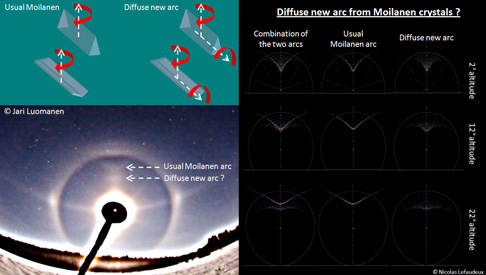I would like to share some thoughts about a possible new arc. This arc seems to be present on the two observations of Moilanen arc at high source elevation from Jari Luomanen ( 1 ) and Marko Mikkilä ( 2 ). It appears as a diffuse glow below Moilanen arc. This arc can be simulated using any crystal producing Moilanen arc like 34deg prism pointing up (which is not aerodynamically stable) or crystal plates twinned at 34deg (which does not look like a possible twinning) tumbling with large angles along their horizontal axis. As a consequence, this new arc does not help a lot on identifying what crystals cause Moilanen arc.
At lower source elevation, the new arc would mix with the usual Moilanen arc so it is difficult to make the distinction between the two arcs. The main difference is that usual Moilanen appears as a hollow “V” while new arc would be more like a solid wedge. This new arc could be responsible of some appearance of the Moilanen arc when it appears as diffuse ( 3 ) compared to more usual sharp arc ( 4 ).
To draw a parallel, the usual sharp Moilanen is a bit like the upper sunvex Parry arc while the new arc is more like the upper tangent arc. To the extremes, if the crystals take all the rotational angles, there would be a lower component like the lower tangent arc, or if the source is very high, there would be a complete circle like the circumscribed halo.
More observations are needed to confirm the existence of this arc especially at high source elevation when it is clearly separated from usual Moilanen arc, so monitoring about this possibility is encouraged!
Nicolas Lefaudeux

This is crazy more new unknown arcs. It only keeps getting better.
ReplyDeleteVery clear presentation of the issue. The feature in Mikkilä's photo was recognized at the time, but apparently it was not clear enough to activate but briefly passing interest. Now that you pointed out also similar spot in Luomanen's photo, the issue is getting more flesh. Good catch! More to look for coming winter.
ReplyDeleteI prefer when the simulations are photo realistic. All the halos that we understand can be pretty much simulated with that quality. The sharp arcs in your simulations don't really have similarity with that fuzzy spot in the photos.
Small crystals make diffuse halos. The Resolute display that you point out originated from snow blower and near the blower the halos were diffuse and weak, only 22 halo was seen nearby. As I walked further away the halos got more defined as crystals grew (the record of all this can be found from our circular from that year). In my view, the diffuse looks of the arc in that display is caused by crystals that are still rather small. Anybody who has been doing snow gun halos knows how halos are diffuse near the source. And that photo has been scanned from slide, which reduces its quality markedly. In the circular there is drawing of the actualy shape of this Moilanen arc, drawn as it looks in the original.
As you say, the new effect that you simulate shows up at higher light source elevations as well. I would think we would have seen it by now around the high moon in diamond dusts. Or at least found from photos. Many times when we see Moilanen arc in spotlight beam, we don't see it with the moon if it is too high. But this new effect should nevertheless show up.
Marko, another possible candidate for low source observation of this arc is your picture from Himos display on which the wedge aspect is really apparent.
ReplyDeleteAgain it is difficult to tell for sure, but the aspect of the Moilanen is quite different from other observations
http://www.ursa.fi/~riikonen/Rovaniemi/pages/0500.htm